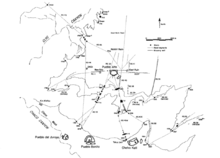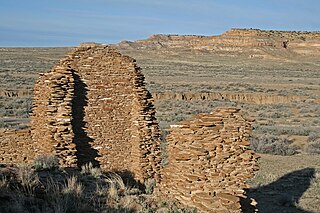
Una Vida is an archaeological site located in Chaco Canyon, San Juan County, New Mexico, United States. According to tree rings surrounding the site, its construction began around 800 AD, at the same time as Pueblo Bonito, and it is one of the three earliest Chacoan Ancestral Puebloan great houses. Comprising at least two stories and 160 rooms, it shares an arc or D-shaped design with its contemporaries, Peñasco Blanco and Pueblo Bonito, but has a unique "dog leg" addition made necessary by topography. It is located in one of the canyon's major side drainages, near Gallo Wash, and was massively expanded after 930 AD.

Chetro Ketl is an Ancestral Puebloan great house and archeological site located in Chaco Culture National Historical Park, New Mexico, United States. Construction on Chetro Ketl began c. 990 and was largely complete by 1075, with significant remodeling occurring in the early and mid-1110s. Following the onset of a severe drought, most Chacoans emigrated from the canyon by 1140; by 1250 Chetro Ketl's last inhabitants had vacated the structure.

Pueblo del Arroyo is an Ancestral Puebloan great house and archaeological site located in Chaco Culture National Historical Park, in New Mexico, United States.
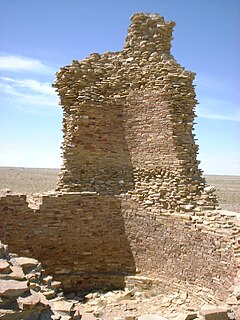
Kin Ya'a is a Chacoan great house and the center of a significant Ancestral Puebloan outlier community. It is located near Crownpoint, New Mexico on the Dutton Plateau, 25 miles (40 km) south of Chaco Canyon.
Escavada Wash is a tributary of the Chaco Wash, in Chaco Canyon, New Mexico, United States. It flows south and west from its origin near Lybrook, New Mexico, and meets the Chaco Wash at the west end of canyon. Several small Ancestral Puebloan archeological sites border the wash, which is located north of the Chacoan great house Pueblo Alto.

A great house is a large, multi-storied Ancestral Puebloan structure; they were built between 850 and 1150. Archeologists differ as to their purpose, but they might have been residences for large numbers of people, or ceremonial centers that only priests occupied. Archeologist Stephen H. Lekson has proposed that they might have been the palaces of Puebloan royalty, particularly those found at Chaco Canyon.
Andrews Outlier is an Ancestral Puebloan archeological site located in the Red Mesa Valley in the southern portion of the San Juan Basin, approximately 50 miles (80 km) south of Chaco Canyon, New Mexico, United States. The site is notable for its three great kivas and thirty small house structures. The area has not been excavated, but the visible architecture indicates that the primary purpose of the buildings was community rituals. Andrews Outlier was occupied from around 900 to 1100 CE. The site is owned by The Archaeological Conservancy and administered by the US Bureau of Land Management.

Bis sa'ani is an Ancestral Puebloan great house and small house community and archeological site. Located in Chaco Canyon, New Mexico, United States, it contains thirty-five rooms and lies near the south of Escavada Wash 8 miles (13 km) from Pueblo Bonito. While outside the canyon, it is not considered an outlier, but included within the core group of ruins. There are several small house sites in the area, but no great kiva. Bis sa'ani was occupied during the early 11th century.

Bonito Phase is an archeological term that refers to the period between 900 and 1140 CE, during which the Ancestral Puebloans in the Chaco Canyon area constructed numerous great houses. The system is divided into three parts: the Early Bonito phase from 900 to 1040; the Classic Bonito phase from 1040 to 1100, and the Late Bonito phase from 1100 to 1140. When the system was created in the 1980s, it was thought that construction at Pueblo Bonito began around 920, but it is now known that building at the great house started almost one hundred years earlier, c. 850.
Bluff Great House is an Ancestral Puebloan great house and archeological site located in southeastern Utah, United States. The site lies near the north bank of the San Juan River, approximately 130 miles (210 km) northwest of Chaco Culture National Historical Park. It contained between fifty and sixty rooms, with four kivas and a great kiva nearby. Two ancient road segments were found in the area, and several berms were leveled to create a terrace, which is rare in Chacoan sites. The great house was partially excavated from 1996 to 2004, and archeologists believe the site was constructed, in at least two stages, between 1075 and 1150 CE by Chacoans who interacted with the Puebloan residents of both Mesa Verde and Kayenta, Arizona. Bluff Great House was abandoned c. 1250.
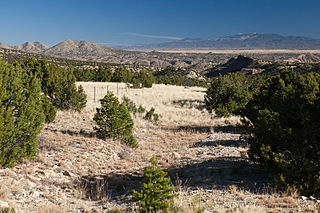
The Cerrillos Turquoise Mines are Ancestral Puebloan turquoise mines located in the Cerrillos Hills, 20 miles (32 km) southwest of Santa Fe, New Mexico. Archeologists believe that most of the turquoise found at Chaco Canyon was mined in the Cerrillos Hills. Many modern Pueblo people claim to have ancient rights to these mines. In 1977, neutron activation analysis linked an artifact from Chetro Ketl to the Cerrillos mines.
The Chaco Meridian is a theoretical north-south axis on which lie the Ancestral Puebloan sites, Aztec Ruins and Chaco Canyon, as well as Paquime at Casas Grandes in northern Mexico. Archeologist Stephen H. Lekson developed the theory, which suggests the location of these sites on the same approximate line of longitude (107°57'25") was intentional, and represents a ceremonial connection between them.
The Chacra Face Road is one of eight Ancestral Puebloan roads that enters Chaco Canyon, New Mexico. It enters the canyon through a break in the Chacra Mesa called the Fajada Gap, and ends at the great house Una Vida. It probably connected Una Vida to an eastern Puebloan community, Guadalupe Outlier.
Coyote Canyon Road is an Ancestral Puebloan road that leads from South Gap in Chaco Canyon, New Mexico, to the southwest region of the San Juan Basin. The road is believed to lead to the Grey Ridge community north of Gallup, New Mexico, but only segments of it have been identified. A segment of the road was discovered between the great houses Kin Klizhin and Kin Bineola.
East Community is an Ancestral Puebloan great house community and archeological site located 12 miles (19 km) east of Pueblo Bonito, at the eastern end of Chaco Culture National Historical Park, New Mexico. Archeological evidence uncovered during the 1980s suggests the site was occupied by both Chacoans and Mesa Verdeans. Eighty-two structures have been identified in the area, including a great house that contains twenty-five rooms and several small house sites. At least one kiva has been uncovered there, but no great kivas. A partial road segment is visible there, but archeologists are unsure of it connects with a longer segment thought to originate near Pueblo Pintado. The great house at East Community was constructed in the 10th century, with significant additions completed during the 11th century. The associated small house sites were occupied by Chacoans from 875 to 1300, and thirty-nine of them by Mesa Verdeans, from 1175 to 1300. Archeologist Thomas Windes believes the site was linked to Chaco Canyon through a system of signaling stations atop the area's mesas.

Halfway House Outlier is a small, twelve-room, one-story Ancestral Puebloan great house and archeological site located in New Mexico, United States. It lies halfway between Chaco Canyon and Salmon Ruins, on the Great North Road. Halfway House appears to have been built in relation to the road, and was probably an orientation point used during the road's construction.
Hogback Outlier is an Ancestral Puebloan outlier community located 50 miles (80 km) northwest of Chaco Culture National Historical Park, New Mexico. The community features a great house, great kiva, and thirty-five small house sites.
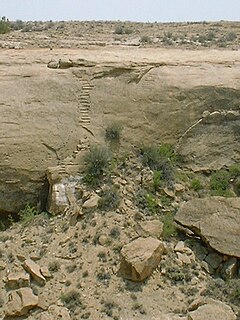
The Jackson Staircase is a pair of Ancestral Puebloan steps cut into the cliff of Chaco Canyon, New Mexico. Located north of Chetro Ketl and east of Pueblo Alto, the stairs gave Chacoans access to the Great North Road. The feature is named after William Henry Jackson, who discovered the stairs in 1877.
Mexican Springs Road is an Ancestral Puebloan road that parallels Coyote Canyon Road. It runs from South Gap in Chaco Canyon to the southwestern portion of the San Juan Basin. It has only been identified through aerial photography, and no physical trace of it is visible from the ground. The lack of pueblos along its path has led some to question its designation as a Chacoan road.
Navajo Springs Outlier is an Ancestral Puebloan outlier community located 120 miles (190 km) southwest of Chaco Culture National Historical Park, New Mexico. The great house is one of the more westerly Chacoan pueblos. Three small house sites are located nearby, as are several midden piles. The site also contains a great kiva and seven berms. Two ancient roads connect portions of the site, which is protected by the Navajo Nation.
